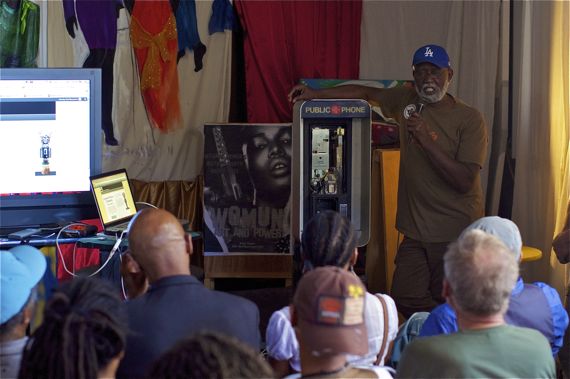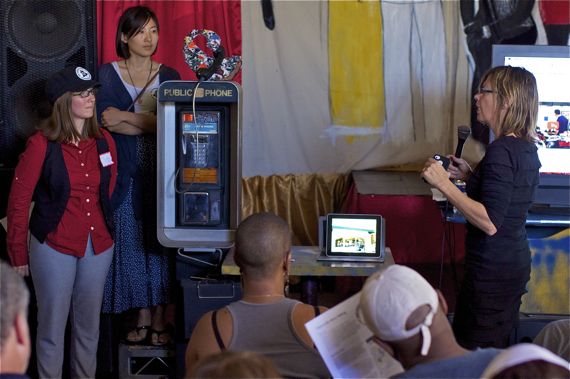
When is the last time you used a public payphone?
Yeah, think hard for a second.
It's been a while, huh?
That's what Ben Caldwell of the KAOS Network and the good people at the USC Annenberg Innovation Lab thought.
After Caldwell saw a segment on the repurposing of payphones as ATMs, he looked at the dead phone outside his door at KAOS and, as he is rather magically wont to do with just about everything he comes across, wondered what artists could do with it.
Word is slowly getting out that Leimert Park is a cultural oasis with a rich history in a lovely neighborhood and many residents are concerned that rapid gentrification could push out the very people and businesses that make it so special.
Could the humble payphone, Caldwell wanted to know, be transformed into something that could serve as a portal to that cultural history while also acting as a draw that could benefit the businesses in the community?
As he is also rather wont to do, Francois Bar, professor at Annenberg's School of Communications and Journalism, said, why, yes, it probably could.
And behold: the Leimert Phone Company was born.
The project is an outgrowth of a 5-week experimental course created and run by Bar and Caldwell, with the aid of grad students Benjamin Stokes and Karl Baumann. Students in the course -- drawn from both USC and the Leimert community -- worked to map neighborhood assets and strategize ways to promote those assets so as to serve the larger goals of contributing to the preservation of and promoting investment in the community. And, of course, they hacked into the 12 payphones USC had purchased for the project.
Last Saturday, April 6, the students pitched their conceptual prototypes on site at the KAOS Network for their fellow students, community members, and a panel of three judges. The judges -- Anthony Maddox, USC professor of both Clinical Education and Engineering, C.Z. Wilson, former Vice Chancellor at UCLA, and Barbara Osborn of the Liberty Hill Foundation -- were there to help students focus their projects and offer real-world feedback with regard to how funders might assess their ideas.
The Dial-a-Track project, inviting listeners to sample local music, find out more about upcoming shows, get discounts for local businesses, or record their own message/track, for example, was simple, straightforward, and engaging enough to get the panel excited. Perhaps inspired by local artist and project participant Wo'se Kofi's music, the judges suggested asking major media corporations to sponsor rap contests linked to the payphones or exploring the extent to which Metro might be interested in collaborating with them on cultural preservation and promotion, given the impending arrival of the Crenshaw Line through the neighborhood.
Meanwhile, the Transmedia Storytelling project, despite staying very true to the underlying mission of bridging the past and the present, was deemed a bit harder sell. The team's idea was to have the phones serve as Wi-Fi stations patrons of local businesses could access by dropping a quarter into the machine. The Sankofa Search website that would pop up as the homepage would serve to guide users through the neighborhood in search of the Sankofa bird stickers, murals, or statues indicating locations where stories from community members could be heard or told.
The panel liked the intentionality of the project and use of the Sankofa -- a bird reaching back and picking up an egg off its back (symbolizing the proverb "it is not wrong to go back for that which you have forgotten") -- but weren't sure funders would go for it without more focus. Maddox thought, if tweaked, the project could serve a docent function, offering visitors a unique form of a walking tour of the area. While Wilson thought perhaps it the phones could be a culturally engaging way to encourage people in the area to use the Internet, as South L.A. is affected by the digital divide.

Undaunted, Caldwell noted that capturing the stories of inhabitants and mapping the neighborhood's treasures was an ongoing project of his and invited the audience to come back over the summer to participate in capturing their histories.
Finally, the smART Phone project looked to feature local artists and businesses on a rotating, monthly basis. A viewfinder in the coin slot would allow passersby to see art pieces, learn about shows in the area, and then head to the nearby business or studio showcasing those pieces to connect with community members in person. The phones themselves would be redesigned to fit with the heritage of the community and placed throughout the area to attract and engage the viewer, helping them realize they had stumbled onto some sort of cultural portal. The phones, the team hoped, would eventually become an identifier of the community (click here to see mock-up).
You're taking something out of the community, repurposing and refurbishing it, and replanting it back in the community, one of the panelists mused in summarizing his thoughts on all three presentations.
The challenge is to do it in a way that the community can connect with.
In the end, everyone seemed to be in agreement with the idea that it is vital for innovators and community members to both collaborate and be involved in shaping the next phase of development in Leimert Park.
The question is, can public payphone projects serve that purpose?
I don't know for sure. But I do know everything is better with a little Snake Doctor thrown in the mix.
For more about the Leimert Phone Company, visit their site here.
Learn more about the upcoming Sankofa Salons in Leimert Park this May.






